Web2 has shaped our digital society. It invited every person interacting with the web to subscribe, follow, share, consume, promote, invest and engage, often through a number of intermediaries such Google, Amazon and social media platforms. Along the way, some who had experienced the former state of the web, have come to miss it. Others, who haven’t experienced web1, but are aware of the many implications of our interactions with web2, might also be missing web1, unknowingly. Lastly, some might wonder “What are you on about, what’s wrong with the web (being web2)?”.
Todays web
Web 2.0 is what most of us have experienced the World Wide Web as. Mainly enabled by big tech companies providing users a very abstracted and convenient way to interact with the web, while having centralized control of their online data. Its huge involvement into our cyborg self can’t be overlooked; we have a scattered our presence accross platforms and services that host our personal and public media, interaction and financial statistics, and even our identification, to name a few. A distinct differentiation between web2 and web1/web3 is the centralization of our data. The avarage user of the internet hardly worries about logically managing and maintaining their online data, as most data is created, stored and maintained within the platforms we interface with. Generally speaking, all the data we require to manage are our login credentials, which, again, are stored and checked in a centralized manner. Most who started using the web in the past 15 or so years do not know any better (or worse) actually. So, what is it that we are missing?
Before the centralized web
I think it is important to realize that web 1.0, as the name kind of implies, was formed as a result of the technical state of the internet and the capabilities and expectations of it’s users (devices and humans). Many interesting technologies like email and graphical websites made use of the newly originated web protocols. Websites were static pages interconnected with hyperlinks, mostly self-hosted or at least self managed. It was void of sophisticated web apps, smart/targeted/interactive advertization services. Online interaction required an unabstracted and uninterfaced participation where you had to make use of the technologies directly. While all of that seems rather crude and unfriendly for motivating web participation, it provided a very raw and genuine experience. With no intermediaries that decide your content, user rights, data management and platform features, the interactions you had with other humans was direct, and required effort from both sides. In some way, there was more value attached to your online interactions, as you were closer to the technology that provides you the ability to do all these things. And also, with void of things like public/global user score statistics like a subscriber/follower counts that shift the motivation for genuine social connection to arbitrary social scores, we could argue that we have forgotten the pure intention of interacting online. With the shift to centralization, intermediaries hold all the data and gain the power to get us more engaged and feed ad space, dictate our access (and by extension, behavior), and increase the required dependency to be self-hosters of our own online presence.
What could happen
Web 3.0 could, possible, provide us the decentralized aspect of web 1.0 without taking away the very user friendly and convenient access to the web we use. It relies on blockchain technology, which, while it has caused many people to be sceptical in its ability to provide much good for us due to many unfortunate events, in its fundamental workings, could enable us to take control away from centralized intermediaries while still leaving them the power to create the things we have come to find very important to use. Take the centralized way of your google account providing you access to many different services for example, which is an (limited) interoperable way of authenticating yourself across the internet. A completely decentralized blockchain enabled method of doing this is possible with your digital wallet, which only you have the ability to prove its ownership, while still being exposed on the block chain for services to use it to authenticate you and use as much data as you decide to give it. Now, I do not know the extend this adoption can be realised, considering the ease of use and user friendly technologies are still lacking at this moment. I believe that a big factor for this realization is the desire for people to take power away from the centralized intermediaries and if there will be a convergence of a smooth experience between users and the user friendly technologies. While this happens though, I also do not think many companies whose growth and innovation depends on centralized user data will have much incentive to adopt these technologies. Nonetheless I’m interested in seeing how much of web 3.0 will could help us get some of that web 1.0 back into our web experiences.



The web 3.0 is an interesting concept. It would be a major step forward in the development of the web but I doubt the ability of the current web 2.0 to adopt this change. The current web 2.0 is probably firmly rusted shut with many stakeholders that don’t want a massive change.
I think the benefits the web 3 that would bring to the web, is interesting. As it will give more control over the user data nad thus more security and privacy to a certain extent. Other features could be introduced as well.